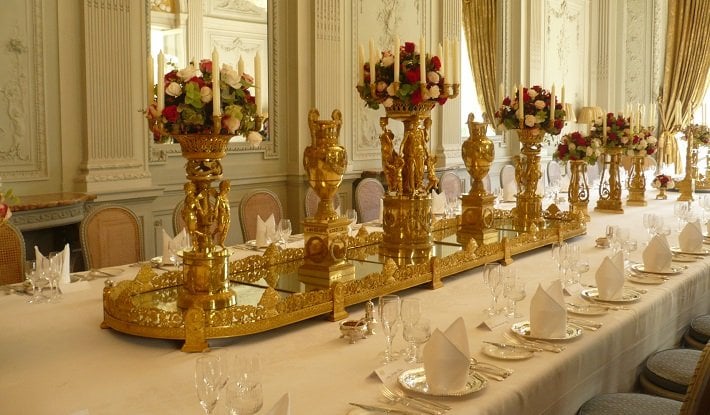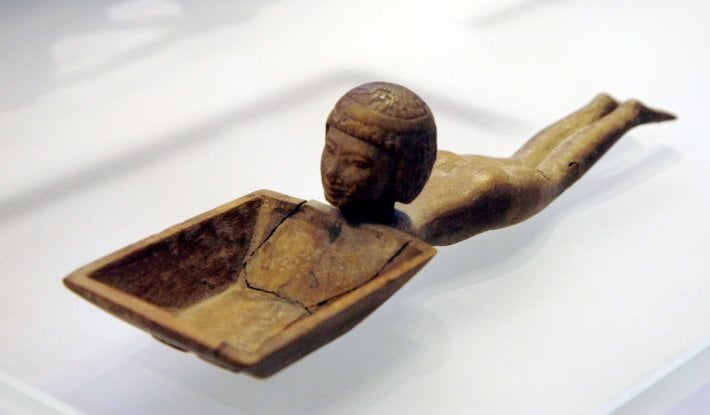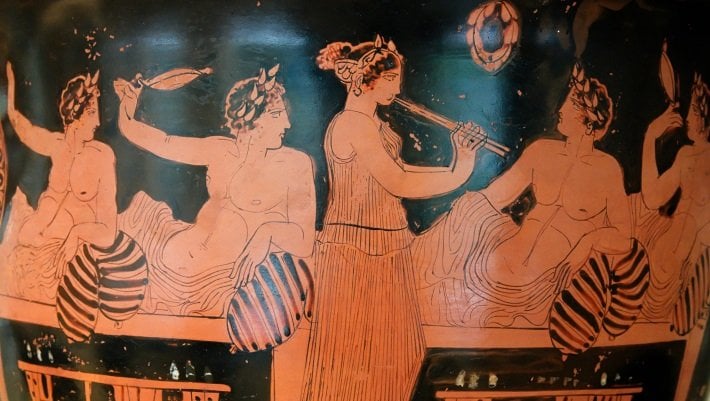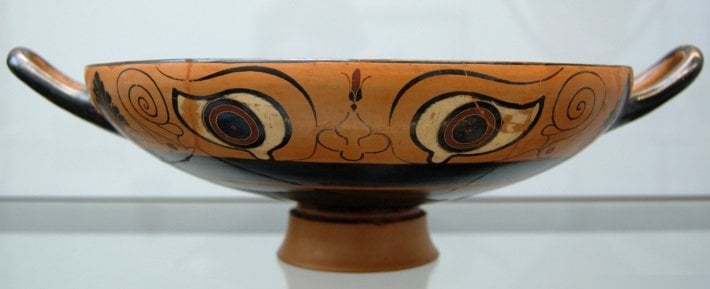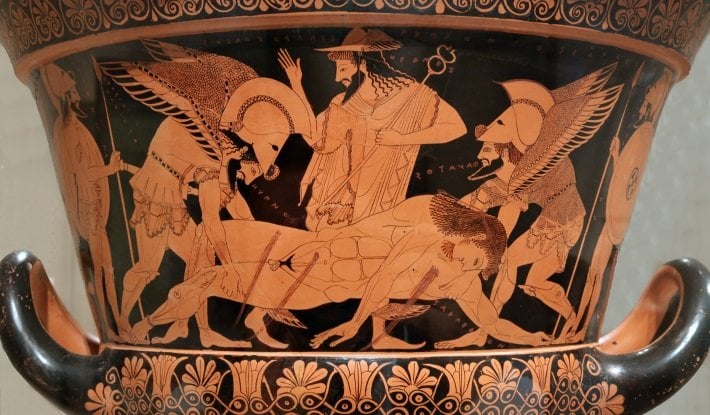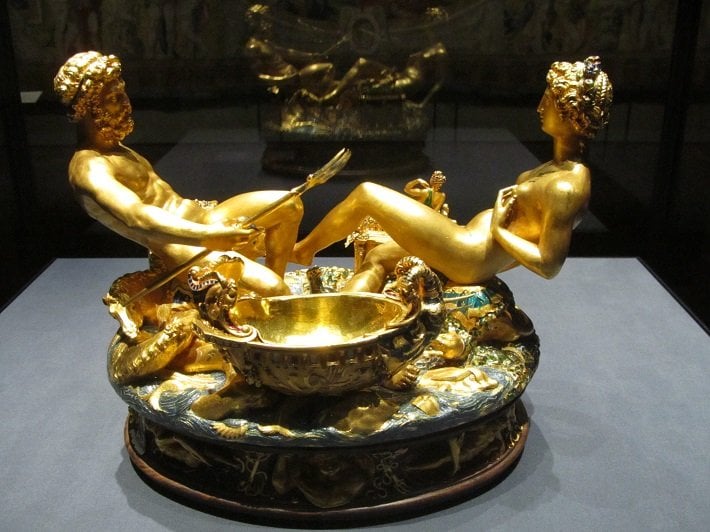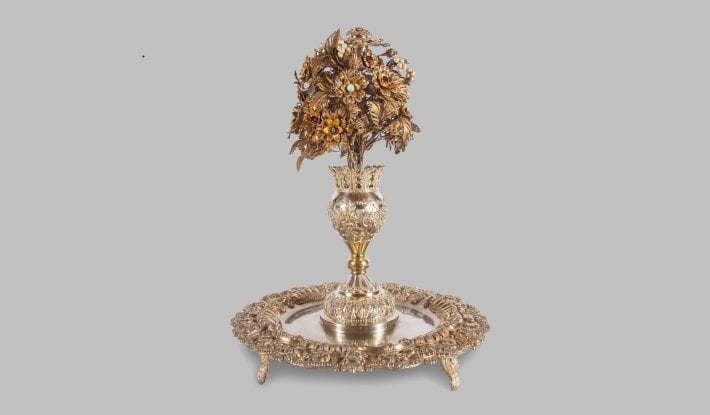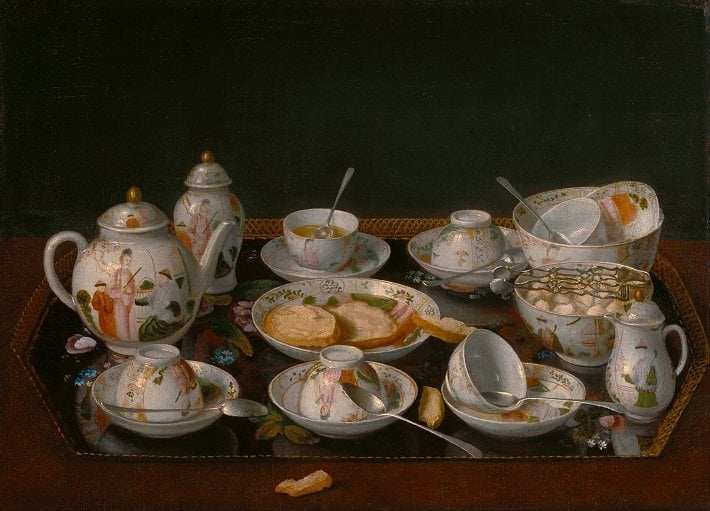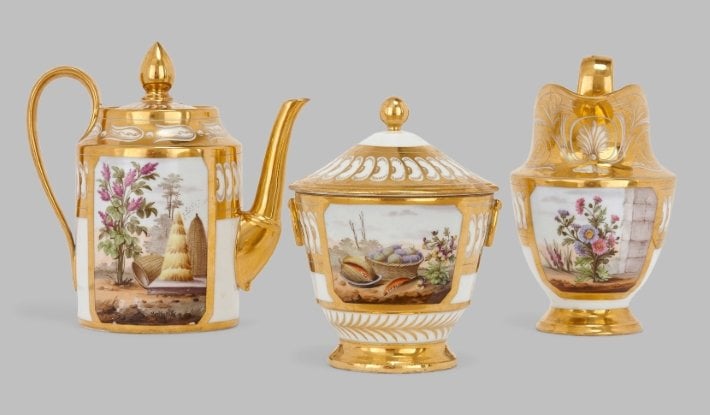Tableware is associated with the most essential human activities: eating, drinking and socialising. We may take them for granted, but plates, bowls, glasses, and cutlery all have a long and complex history.
The Mayfair Gallery history of antique tableware reveals this fascinating story, from the creation of the very first spoon to the present day.
The earliest utensils
Although we might not associate our early ancestors with fine dining, there is evidence that cavemen used basic objects as implements for eating.
The oldest tableware implement that came into being was an early form of spoon. This is partly because, unlike knives and forks that have to be fashioned, spoon shaped utensils can be formed from natural resources.
In prehistoric times, our ancestors used seashells and hollowed stones to scoop up their food.
Although these early instruments didn’t resemble ‘spoons’ in the conventional sense, they nonetheless represent the very earliest use of tableware.
Gradually, the people of these ancient civilisations began to create more complex utensils.
Sticks and bone handles were added to the naturally occurring, spoon-like implements, resulting in more sophisticated dining.
Similarly, in the Stone Age, our ancestors crafted mugs from carved bone and fired clay.
Spoons in ancient Egypt
While there is no definitive date that can be attributed to the invention of cutlery as we know it today, there is evidence of spoons with conventional handles from ancient Egypt.
As early as 1000 BC, the ancient Egyptians were using elaborate ivory, wood and precious metal spoons for a variety of applications.
Often these spoons would be elaborately decorated with hieroglyphs and images of ancient Egyptian mythology.
It is interesting that these first spoons were used not just for eating, but for ritualistic purposes and ceremonies of medicinal healing.
In addition, spoons were often used for cosmetic purposes.
A brilliant example of this is a 6th Century BC spoon made of carob wood, shown below, which was used for the application of eyeliner for wealthy ancient Egyptians.
6th Century BC ancient Egyptian spoon, used for cosmetics. © Rama via Wikimedia Commons
The spoon features a depiction of a young, lithe girl as its handle. Her beauty reflects the cosmetic nature of the item, and reminds the user of its purpose.
Clearly, in ancient Egypt spoons had a more significant and important status than simply being functional objects for eating.
Indeed, it appears when these early spoons were used for dining purposes by the upper echelons of society, they were highly ornate and decorative.
The ancient Egyptian Pharaohs used spoons made of fine gold and silver, which were engraved with beautiful artistic embellishments.
Thus even from its very beginning, high quality tableware was representative of more complex ideas than just functionality, becoming synonymous with wealth, power and status.
Drinkware and the rituals of ancient Greece
A similar phenomenon was true of tableware in ancient Greek society: the more elaborate the piece, the wealthier its owner.
For the Greeks, communal dining and eating out was considered to be a very important aspect of society.
The Greeks in particular placed high importance on convivial drinking and eating.
In ancient Athenian society, social groups would regularly hold symposia, which broadly translates to a formalised drinking party.
Attic red figure krater from Athens, depicting reclining men at a symposium with a female musician. © Nikias Painter via Wikimedia Commons
These all male, stylised gatherings formed part of the banquet, but took place after the main meal had occurred.
Symposia were an aristocratic institution: an opportunity for men of the ruling classes to drink, debate, plot, celebrate and enjoy the company of others and the entertainment of performers such as musicians.
At all symposia, drinkware – another ancient form of tableware – played a central role in the proceedings.
The ancient Greeks believed that drinking unmixed wine was the habit of uncivilised nations.
As a result, they mixed their wine with water in huge vessels called kraters, which were then placed at the centre of the drinking party.
The wine was served to guests in kylixes, which were broad, shallow wine drinking cups with two handles.
Symposia tableware such as kraters and kylixes are fascinating, because of their decoration.
The designs of these could often be subversive or humorous in nature, as exemplified in the below late 6th Century BC ‘eye-cup’ from Chalkis, which features decorative eyes painted on the external surface.
Late 6th Century Greek kylix, from Chalkis
When used as a drinking vessel, the kylix would be tipped up. With its painted eyes, handles resembling ears, and base like a mouth, drinking from the eye cup would have resulted in the user looking like they were wearing a mask.
Similarly impressive, although less jovial in nature, is the Euphronios krater, also created in the late 6th Century BC.
This stunning work, pictured below, features the profound image of a dead youth being gently lifted from the battlefield.
The Euphronios krater, late 6th Century BC
The message is a timeless, universal one, which stresses the brevity of life.
It is a beautiful, powerful image, designed to add gravity to the symposium’s celebrations.
The shared experience afforded by ancient Greek dining transformed tableware from simply practical pieces, to objects that could be playful, political and powerful in nature.
Eating out in ancient Rome
For the ancient Romans too, communal dining was considered an essential component of society.
However, unlike ancient Greece, where eating out took place among the upper classes in a private home, the ancient Romans also encouraged more public dining, accessible to those from all walks of society.
These public dining venues took the form of thermopolia, which were small restaurant-bars that offered food and drinks to customers.
Typical thermopolia had small, L-shaped counters into which large jars were sunk. These sunken jars contained wine and hot and cold food, which could be selected by customers.
The remains of an ancient Roman thermopolis in Herculaneum, 1st Century AD. © Aldo Ardetti at Italian Wikipedia via Wikimedia Commons
Evidence of ancient Roman tableware has been found with the ruins of many thermopolia. Jugs, plates, spoons and knives were all used, most of which are of fairly crude and rudimentary design.
Thermopolia were extremely popular in ancient Rome, particularly among the lower classes of society who did not necessarily have kitchens in their homes.
The style of tableware used at the thermopolia became associated with the simple food served and the poorer class of customer who frequented the establishments.
In a bid to distinguish themselves, the ancient Roman upper classes began to commission ever more impressive items with which to adorn their tables.
These included items crafted from fluorspar, which was highly prized in ancient times.
Indeed, the Emperor Nero is reported to have paid over one million sesterces for a single fluorspar cup, when the average Roman soldier earnt just nine hundred sesterces a year.
Tableware in the Middle Ages
After the fall of the Roman Empire in the 5th Century, the production of fine tableware fell into decline.
Although the nobility maintained high standards, among the lower and middle classes tableware became simpler and plainer.
Bowls, plates and cutlery tended to be carved from wood, which was the material of choice on account of its natural abundance and inexpensive cost.
A beautiful folio from the 14th Century depicts a group of peasants breaking bread, and provides a good impression of the tableware used at the time.
Folio decoration from a 14th Century French illuminated manuscript showing peasants breaking bread
Jugs and bowls of simple shapes are used, and although the bread is cut with a large knife, it is eaten without other utensils.
There is only one jug and drinking bowl among the group, representing the communal nature of the dining.
Individual drinking cups took the form of basic tankards, which were often made of pewter. The dark colouring of pewter also helped to hide impurities that could be found floating in many beers.
High society and the importance of salt
In contrast, among the upper classes in Medieval Europe, tableware became ever more important.
By hosting banquets at which fine tableware was used, the aristocracy were able to convey their wealth and status to guests.
Beautiful golden goblets, large platters and sumptuous courses were all features of medieval banquets.
Such features can be clearly distinguished in a portrayal of a 14th Century banquet hosted by King Charles V of France.
Depiction of a banquet given in Paris in 1378 by Charles V France (center, blue) for Charles IV, Holy Roman Emperor (left)
Servants are depicted bringing in platters heavy with rich food, and each dining guest has his own set of two knives, napkins, bread and a plate.
Intriguingly, each diner also has his own individual square container for salt, which in medieval times, was considered a hugely precious commodity.
Such was the importance of salt that it was referred to as “white gold” and its value meant that it could be used as a currency for trade.
At medieval banquets, much emphasis was placed on the presence of large quantities of salt, which conveyed the host’s wealth.
The importance afforded to salt is evident by the tableware that was created to contain the material, as demonstrated in the below depiction of the Duke of Berry enjoying a fine meal. On the left of the Duke is a model of a large golden ship, or nef, acting as a salt cellar.
Depiction of John, Duke of Berry, enjoying a grand meal, by Herman, Paul and Jean de Limbourg 1413-16. To the left of the Duke is a large golden nef, which serves as a salt cellar.
The golden celler is clearly the most ornate and extravagent item of tableware present, demonstrating the importance of salt.
Its large size, with the capacity to hold a vast quantity of salt, is a visual demonstration of the Duke’s wealth and status.
The Cellini Salt Cellar and dining in the Renaissance
Salt retained its lucrative stature as ingredient de rigueur well into the Renaissance period.
Salt cellars became the ultimate luxury item at the dinner table and highly elaborate sculptural works would be crafted to store only a tiny quantity of salt.
Undoubtedly the most famous example of these creations is the Cellini Salt Cellar, now housed at the Kunsthistorisches Museum in Vienna.
The Cellini Salt Cellar © Cstutz via Wikimedia Commons
Created by Italian sculptor Benvenuto Cellini in the late 16th Century, this exceptional work in the Mannerist style was made for King Francis I of France.
Delicately crafted of gold, enamel, ivory and ebony, the salt cellar portrays Neptune, god of the sea, and Tellus, goddess of land, as representative of the oceans and the earth respectively.
Sat with their legs entwined, a model boat is positioned between Neptune and Tellus, used for containing salt.
The Cellini Salt Cellar was made with bearings on its underside, so that it could be moved around easily.
Thus when Francis I pushed the beautiful item around the table, he was – metaphorically – moving the world. The Cellini Salt Cellar is an item of tableware that represents power, status and control.
The trend for elaborate salt cellars sparked in medieval times and the Renaissance continued into later centuries, as is evident from the items of beautiful antique tableware that were produced.
Mayfair Gallery's 19th Century precious stone and parcel gilt silver filigree salt, demonstrating the importance associated with salt as a commodity even in later centuries
Renaissance revival in glassware
Also in the Renaissance period, fine glass tableware experienced a dramatic revival in production.
Although the ancient Romans had pioneered the use of glass as a material and made great progress, after the fall of the Roman Empire glass production became a largely lost art form.
However, early Renaissance craftsmen in Venice began to develop new techniques for the production of glass, and by the 15th Century, all manner of exquisite glass tableware was being produced.
One of the most important Renaissance developments was the wine glass. It was not until the late 14th Century that vessels for drinking wine were actually crafted from glass, having previously been crafted in wood, clay or metal.
The fashion for fine glass goblets soon took off, and prestigious Italian glassblowers were commissioned to design beautiful wine glasses at considerable expense.
Since each wine glass was cut from an individual piece of glass, the resulting vessel was a unique, one off piece.
The uniqueness made these wine glasses highly desirable and expensive items, which served not only a practical function, but reminded a guest of his host’s wealth and power.
Opulent display and 18th Century tableware
As the centuries progressed, fine dining became a more important tradition than ever before.
Although superb quality glassware was still highly prized, the 18th Century moved away from the Renaissance tradition and instead cut multiple vessels from larger pieces of glass.
Cutting the works from larger pieces of glass allowed for smooth edges and clean lines, as well as the possibility of creating matching sets of items.
Yet the fact that each glass piece no longer had to be individually designed did not negate its value.
Indeed, the new technique meant that wealthy families could now commission an entire set of glasses, to be created exactly as they pleased and all in the same image.
Set of sixty one drinking glasses by French maker Saint Louis Glassworks, crafted in the traditional 18th Century style but dating to the 20th Century
It was common to include decorative features such as family crests or markings on sets of wine glasses, to remind guests of the status and heritage of their host.
The impact of Louis XIV on tableware
In the 17th and 18th Centuries, the European upper classes defined their high status by the elegance and beauty of the objects that they owned.
Striving to impress, wealthy aristocrats commissioned increasingly more elaborate items of tableware.
This phenomenon was, in part, due to the French King Louis XIV. Also known as Louis Le Grand or the ‘Sun King’, Louis XIV changed French and wider European dining habits for years to come.
Louis XIV ordered that his kitchen spare no expense, and prepare excessive amounts of lavish and expensive food.
The King’s average dinner was said to be comprised of at least twenty dishes, served over four different courses.
To accommodate such impressive feasts, tableware became of central importance. Silver, gold, and other precious materials were all used in the creation of beautiful tableware, particularly large platters, which were used to accommodate food.
Time for tea: an English institution
While the French court was concerned with the number of courses served, the English nobility had its sights on a new trend.
Tea was first retailed in England in the mid-17th Century, but it was not until the 18th Century that it became truly sought after.
On account of it being imported from exotic and distant lands, tea was an extremely expensive commodity in the 18th Century.
As a result, the serving and drinking of tea was permeated with significance and tradition.
Stunning and elaborate tea sets were created for the ritual of taking tea, which defined respectability and also supported the rise and rule of the British Empire.
That tea was associated with exotic lands can be seen in the tableware that was produced to serve tea in at the time.
The porcelain tea set below, for example, is a Chinese set belonging to a French household in the later 18th Century. The Chinese-style decorations on the individual items highlight the indelible association between tea drinking and the exoticism of the Far East.
Antique tea set painted as a still life by the 18th Century French artist Jean-Etienne Liotard (1702-1789)
Inspired by the British tastes, other European countries soon followed suit, and the serving of tea from exquisite porcelain and silver wares became ubiquitous across the continent.
Detail from Mayfair Gallery's Empire period Paris porcelain tea and coffee service, 19th Century
Centrepieces in the 18th Century
In the 18th century, service à la russe (with servants handing food dishes to the guests one by one) cleared more room on the table for decorations, such as centrepieces and vases.
An important innovation to the fine dining table in the 18th Century was the rise of the surtout-de-table, a long, flat centrepiece, often with a mirrored surface, which was laid on the table to hold and reflect the other table decorations.
Surtout-de-tables were enormously popular among the European aristocracy in the 18th Century and splendid decorations on a dining table came to symbolise the wealth and prestige of the host, and to remind guests of the high quality of entertainment being provided.
Yet although the fashion for the centrepiece emerged in the 18th Century, it was the 19th Century which saw the most magnificent centrepieces made.
It was at this time that the custom of adding flowers to the table was revived too. The addition of floral decorations to a dining table was actually an ancient Roman custom, which was revived in the 19th Century as part of the new vogue for Classical art and design known as Neoclassicism.
By the late 19th century, flowers and foliage on the table often reflected the season or theme of the event, such as white flowers for a snow-themed event.
Antique tableware in the modern era
The emergence of the centrepiece demonstrates the extent to which tableware had evolved to serve a decorative as well as a practical function. The history of antique tableware is therefore a history of design and beauty, as well as functionality.
It is because tableware is associated with the most basic of human activities – eating, drinking and socialising – that, over the centuries, pieces of tableware had grown from mere practical objects to works of art in their own right.
The story of antique tableware tells us not only about how our ancestors used to eat, but about how they entertained, how they chose to display their possessions, and, ultimately, about how they thought of themselves.
Antique pieces of tableware are therefore cultural artefacts as much as they are practical objects.
And it is for this reason that antique tableware is so highly sought after by collectors today, and why antique pieces of tableware are displayed in museums and collections worldwide.
That said, in spite of the more casual nature of dining in the 21st Century, antique tableware can still be used today and the use of antique tableware is especially popular for lavish feasts and fine dining, in much the same way as it was throughout history.




